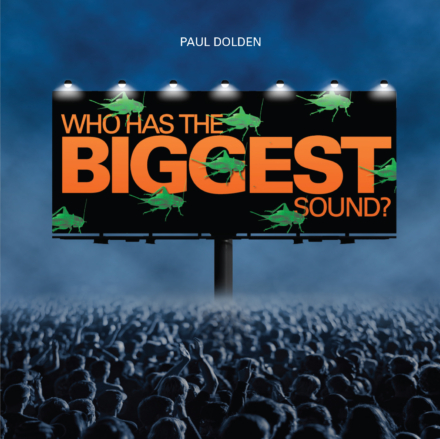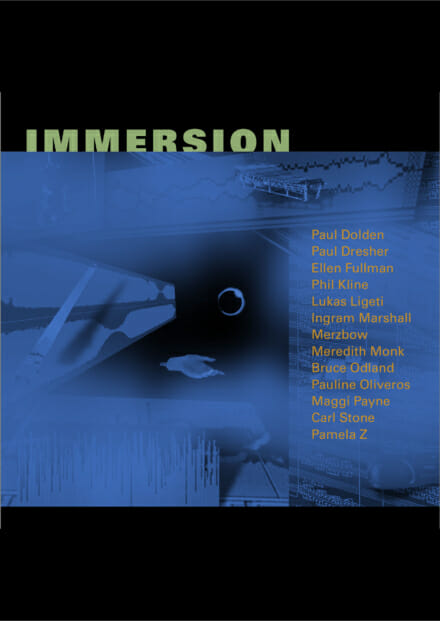Paul Dolden’s Who Has the Biggest Sound? CD is the first recording in over nine years from this electroacoustic wizard. The album premieres two major works that feature the surreal blending of up to 400 layered studio tracks.
Dolden’s music has been widely praised:
New releases from this Canadian composer are rare because of the extraordinary amount of time Dolden takes to build up his richly dense pieces. To create the CD’s major work, the 52-minute Who Has the Biggest Sound, he worked full-time over a 3-year period from November 2005 to December 2008, logging over 6,000 hours in the studio. The CD’s other work, the 18-minute The Un-Tempered Orchestra (2010), required about 1800 studio hours.
Who Has the Biggest Sound? features tongue-in-cheek questions such as: Who Can Play the Fastest? Who Has the Biggest Noise? Who Has the Nicest Melodies? Beyond these queries, however, Dolden develops some highly refined, imaginative, cultural-geographic intersections, such as linking howling dogs with country music and crickets (whose slowed-down chirps emerge in a 6/8 meter) with Spain’s flamenco. Along the way, we hear the Tremolo Trailblazers perform “The Saddle Song,” as well as a Tonic Tango. The work was commissioned by New York’s Diapason Gallery and Montreal’s Réseaux des arts médiatiques.
Noting the composer is “an unparalleled master of digital studio techniques,” Lawrence Joseph remarks that this work “displays Dolden’s talent for mixes that are dense in content yet retain transparency even when layering hundreds of tracks. His unique gift is the ability to imagine and then painstakingly realize orchestrations where the sum is not only greater than the parts, but the results are completely unpredictable from the parts.”
In The Un-Tempered Orchestra, a juxtaposition to Bach’s The Well-Tempered Clavier that explored the new equal-temperament tuning system (the basis for nearly all Western music since), Dolden uses non-tempered tuning systems to create a fresh multicultural space, where Western and non-Western musical practices can co-exist. Dolden first wrote simple diatonic melodies and chord progressions, then recorded Eastern and Western musicians performing these in their native tunings, finally retuning and editing all these together into an asymmetrically tuned whole. At one point, for example, jazz-like solos were retuned into ancient Greek, Babylonian, and Chinese tuning systems, thereby reflecting today’s style back to us altered by ancient tuning systems. The work was commissioned by Germany’s Sinus Ton Festival.
While at times listeners often think they are hearing electronic sounds in these two works, Dolden stresses that all the original material is purely acoustic. Elements may sound electronic because of Dolden’s complex layering, such as a section consisting of 10 dilrubas (an Indian violin), 4 western violins, and 7 Irish folk flutes, which slowly crossfades into 10 suonas (an oboe-like Chinese instrument), 4 western oboes, and 7 neys (Middle Eastern flute), all of which may be digitally retuned. Dolden was first heard on Starkland with his work Twilight’s Dance, in our first-of-its-kind Immersion DVD, for which Starkland commissioned Dolden and 12 other composers to create high-resolution, surround sound compositions exclusively for this DVD-Audio release.
About Paul Dolden
Canadian electroacoustic composer Paul Dolden began his career at age sixteen as a professional electric guitarist, violinist, and cellist. After extensively exploring the possibilities of recording technologies, he arrived at his unique approach of concocting otherwise impossible musical performances. The resulting compositions are characterized by a maximalist aesthetic, in which hundreds of digitally recorded instrumental and vocal performances are layered in up to 500 tracks, to create a new, virtual orchestra, conducted by Dolden with as much sensitivity and finesse as he desires.
Dolden was recognized as a composer of note when, at age 29, he won the first of over 20 international awards he has received, in a career now spanning over thirty years. Dolden has written over 30 commissioned works, including those for: orchestra (Esprit Orchestra, Canada; Phoenix, Switzerland); chamber ensemble (Stockholm Saxophone Quartet, Sweden; Bang on A Can All-Stars, New York); virtuoso soloists (Rivka Golani, Stefan Osterjo, Nancy Ruffer, David Brutti, Francois Houle); and pure electroacoustic music (Groupe de musique électroacoustique de Bourges, France; Réseau & Association de creation et recherché électroacoustique du Québec, Canada; and Starkland, USA).
Dolden’s 2-CD set “L’Ivresse de la Vitesse” (Intoxicated by Speed) from empreintes DIGITALes, widely regarded as a landmark recording, was selected by The Wire as “one of the top 100 recordings of the 20th century.”








